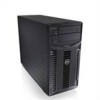Dell PowerEdge T410 Dell PowerEdge Deployment Guide - Page 6
Manual Installation of Microsoft Operating Systems, Microsoft WDS Legacy Images / RIS, WinPE, - hard drive
 |
View all Dell PowerEdge T410 manuals
Add to My Manuals
Save this manual to your list of manuals |
Page 6 highlights
PowerEdge Deployment Guide Manual Installation of Microsoft Operating Systems This installation method involves booting to the operating system installation DVD to complete the installation. Depending on the operating system you are installing, the mass storage drivers may not be included, and therefore, the installation will fail since no hard drives will be seen. Operating systems released prior to Microsoft Windows Server 2008 will look for a floppy disk for the mass storage drivers. Since many servers ship without a floppy drive, this may cause a problem. To assist, Dell developed the Dell USB Key F6 Driver Utility. This utility can be downloaded from www.support.dell.com. The utility allows you to provide the mass storage drivers from a USB key by making the USB key appear to the operating system as a floppy drive. Press when prompted at the beginning of the operating system installation. Please keep in mind that there will likely be other drivers that will need to be installed after the operating system installation is complete. You can determine what devices do not have drivers installed by looking in Device Manager. For the 11th Generation PowerEdge servers, you will also need to install the chipset, Broadcom NetXtreme II, and Matrox G200 video drivers. You may also use the Unified Server Configurator to update drivers and firmware. Microsoft WDS (Legacy Images) / RIS For this deployment service, you will need to ensure that the mass storage driver for the controller in your server, such as the PERC 6, is added per the Microsoft WDS / RIS documentation. See http://technet.microsoft.com/enus/library/cc720099.aspx for more information. You will also need to add the network adapter driver. See Microsoft Knowledge Base article 315279 on http://support.microsoft.com/kb/315279. Remember that starting with the Broadcom NetXtreme II 5709-based adapters, a separate WDS / RIS driver must be used for the text mode portion of the installation due to technology changes needed to support iSCSI and TOE. Dell recommends that the Broadcom drivers be installed using the drivers setup.exe and a cmdlines.txt file. See the Microsoft documentation for a detailed explanation. This will ensure that the network driver version as well as the Broadcom Advanced Control Suite is in sync. For more information see Best Practices for Installation of Microsoft Windows on Dell Servers with Broadcom NetXtreme Devices. Additional information is also available in the Microsoft Knowledge Base article 254078 on http://support.microsoft.com/kb/254078/en. WinPE You will need to add the mass storage driver and network driver based on the Microsoft WinPE documentation. Remember that you must use the latest RIS network driver for the Broadcom NetXtreme 5708 and 5709 adapters. See Best Practices for Installation of Microsoft Windows on Dell Servers with Broadcom NetXtreme Devices for more information. Microsoft Automated Deployment Service (ADS) Dell has observed a problem with ADS when two Intel™ Xeon™ processors are installed. When booting to the Deployment Agent, ADS gives the following error: Windows could not start due to an error while booting the RAMDISK. Windows failed to build a bootable RAMDISK image. System will reboot in 5 seconds. Page 4










